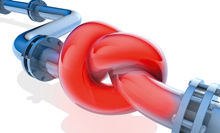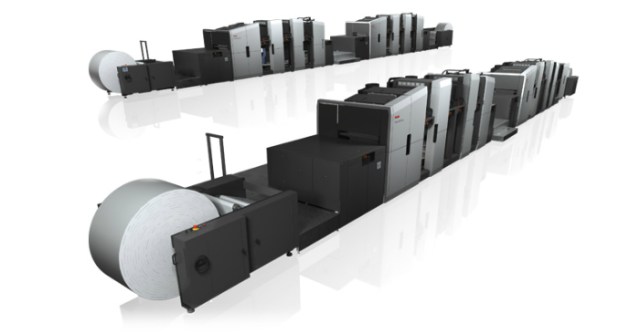
No one can doubt that inkjet takeover is speeding up. As ProPrint went to press, Blue Star had just announced the investment in two HP T300 inkjet webs. But some observers say the technology developers are riding with one foot on the accelerator and the other on the brake. The benefits of this potentially disruptive process are being stalled by some unappealing cost factors, especially when inkjet goes head to head with offset.
A few months ago, ProPrint columnist and print guru professor Frank Romano listed four drags holding back inkjet’s long-term development. Firstly, papers can be up to 40% more expensive than litho stocks, with manufacturers passing on development costs; secondly, the range is limited, as in many cases papers must be pre-coated; thirdly, inkjet ink is pricey (think about desktop inkjet, which Romano says “it is about the same price as champagne”); and finally, there is the issue of the click charge model, which said creates bad habits.
To restrain overheads, businesses tend to opt for a high-volume, low click-charge plan, then pare back prices while running razor-thin margins. He called on suppliers to instead model their sales approach on offset: sell the hardware, and keep consumables and maintenance separate (at least as an option).
One printer looking at inkjet very closely is Bruce Peddlesden, managing director of Australia’s biggest digital house, On Demand Printing in Melbourne. His factory floor is like a showroom for top-tier HP Indigo machines, but Peddlesden is casting a wider net when it comes to his first foray into inkjet. He has sussed out all the players, including Infoprint, Kodak and, of course, HP, but Peddlesden says “the frontrunner is Océ”. Specifically, he is looking at the web-fed ColorStream 3500.
For someone savvy with how to price up sheetfed digital, the brave new world of inkjet requires a new way of thinking. “On cut sheet, you know that costs are going to be X cents per click but with inkjet, it really depends on the ink coverage. If you are basing it on 8% [ink coverage], which is a normal book, you are significantly under 50% of the price [of cut sheet digital for text pages]. It is not the click cost but the ink cost that is the real variable in B&W books. With 30% coverage, you are up for a higher cost. If the books have images, such as training manuals with screen grab, then the more coverage, the more expensive. It is whole new metric,” he says.
Print shops will need to prepare quotes based on expected ink coverage of a job. Inkjet ink might not be cheap now, but Peddlesden is confident that ink costs will come down as inkjet grows and there are increasing number of manufacturers and products in the market.
Mega volumes
One early adopter is Computershare Communication Services, the outbound and inbound communications division of the share registry giant. It recently made a landmark upgrade to its printing fleet.
The division, which began as Chelsea Images in 1982, was acquired by Computershare in 1989. It now has 540 full-time employees in Sydney, Melbourne, Brisbane and Perth, and provides multichannel communications services to some 10,000 clients worldwide. It has 13 production facilities, including Australia but also in the US, Canada, the UK and Germany. Until this year, it outsourced mega-volume essential-mail print runs, focusing on its core variable-data printing (VDP) activities in-house. These kinds of communications, such as promotional campaigns, customer loyalty programs, online bill payments and invoices, shareholder dividend statements, employee share plan correspondence, and communications with brokers and fund managers, have been printed at its facilities around Australia.
Until recently, the modus operandi was toner printing using some 40 Fuji Xerox devices, including iGen3, DP180s (mono/MICR), DT180s (HLC), and Nuvera 288s and 144s on trade-printed offset ‘shells’. But overprinting using laser technology for VDP projects does not lend itself to transpromo, or precision marketing that utilises full colour, says Computershare sales director Ross Ingleton.
This has now largely been replaced by web inkjet. In December, Computershare repatriated its transactional print thanks to the country’s first two InfoPrint 5000s, one in Sydney and another in Melbourne.
Ingleton says the decision to go with InfoPrint came after researching all inkjet contenders, including machines from Océ and Xerox. What clinched it for the Ricoh-owned manufacturer was the global install base of 200 machines.
The Xerox side of the operation is still in tact, he adds. However, talking about volume definitions and “crossover points” at which inkjet becomes more productive than laser/toner is a misnomer. Specialty short-run projects are likely to go on the Xerox machines, while the InfoPrints now churn through the transactional mileage.
Ingleton believes inkjet’s limitations have been overstated. Compared to pre-prints, he claims that one-pass inkjet is not only more cost-effective on medium runs, but draws new demand from essential-mail clients, who can order millions of impressions a year.
(Compared to sheetfed toner printing, inkjet is a higher-quality contender than those earlier toner devices that targeted higher volumes, such as the Fuji Xerox ‘Sugi’ 980. The only one in this country was installed at HPA before its was bought by Salmat, which has also invested in high-volume inkjet, via Océ Jetstream 2200s).
Computershare conducted months of stock testing and found it did not have to limit the InfoPrint to coated substrates for all jobs. Where they are required, he predicts prices will fall as volumes go up. Nor does Ingleton see limitations on range or versatility of papers. “There is an enormous range of stocks that can be used with inkjet, even including security papers and heavyweight papers. With more than 200 InfoPrint 5000 platforms in operation worldwide today, I wouldn’t say it is holding the technology back. I think paper suppliers are now catching up.”
Ink is not the single most expensive component but it is definitely up there, he believes. But equipment manufacturers, print suppliers and customers have a role to play in keeping prices down. He also points to InfoPrint’s monitoring software and an algorithm that enables variable drop sizes as cost savers.
“The click charge model has become an industry standard, whether it is laser printing or inkjet. In today’s market, suppliers offer many different purchase packages or click charge models, and it is up to buyers to negotiate a better position. At the end, we have to present a model to our clients that is relative to volume, and they understand the click-charge model.”
New chapter for inkjet
Beyond transactional work, the other key sector for inkjet has been books. In Australia, proponents include SOS Print & Media, which last year installed a Kodak Prosper 1000, and PMP subsidiary Griffin Press, which has an HP T350 on order.
Another inkjet early adopter is Wellington’s Astra Print, which has been running for 101 years. Its digital division, Printstop, last year became the country’s first site for the Screen Truepress Jet520, supplied by vendor Fujifilm.
Chief executive Steve Messenger believes any cost hurdles posed by substrates or inks are more than countered by the flexibility of cueing short-run jobs without time-outs. The press can generate about 3,200 trade paperback impressions per hour, which translates to almost 200,000 double-sided book pages. This lets Printstop service micro-runs and volume projects of books, sometimes from the same client, as first editions are established and booksellers demand more stocks.
Astra is also examining boutique newspaper editions and remote printing of regional papers. The Truepress can print 1,200 48pp tabloids per hour, with format, substrate, content and pagination changes on the fly, so Messenger believes the premium cover price these copies command makes a case for production inkjet. He is philosophical about the expense of pre-coated papers and inks. “The more volumes migrate to inkjet, the more volumes are available and the more stock will be offered, resulting in lower prices.”
As to availability of substrates, he believes there are sufficient uncoated and book stocks, but he would like to see more coated stocks. On click-charging, he says: “Ink usage can be measured exactly with an inkjet so ink usage should be the charging basis. This encourages users to find smart ways to design for impact without cost. Click-based charging created homogenous products.”
Pricing of substrates
One local printer says pre-coated paper was “horrendously expensive” when his firm installed its high-volume inkjet beast, but that is now coming down.
Screen marketing manager Peter Scott is confident greater demand will lower the pricing of substrates, but adds ”we recently did a comparison with a gloss-coated inkjet stock and a quality gloss-coated offset stock and they are quite comparable price-wise”.
Océ product manager Steven Badger says CrystalPoint, a hybrid toner-inkjet technology used in its ColorWave 600 poster printer, can print on plain and recycled paper.
One vendor noticeably absent from inkjet had been Fuji Xerox. But at Ipex it announced its strategy, showing a concept press eight months later. The press features a patented ink formulation that eliminates the use of water to produce “vibrant, consistent colour” on low-cost offset paper.
Availability of substrates
There are too few suppliers of inkjet receptive papers in web reels, but Scott says those in the market are co-operative and innovative. Screen has relationships with major mills and merchants.
Kodak GCG marketing manager Liana Ansell says the vendor has circumvented any coated paper issues thanks to on-board coating. The Prosper 1000 coats non-treated papers inline to deliver improved quality on lower cost substrates.
Inks
Scott claims the TruePress Jet520’s six-litre packs represent value. “Being a micropiezo system with small picolitre droplets, ink usage is kept to a minimum.”
Ansell says Kodak manufactures its own inks for the entire range of its inkjet solutions. “This allows us to present an extremely aggressive ink pricing strategy and provides our customers one of the lowest costs of operation.”
Click charge
Screen does not have a click-charge model for the Jet 520, says Scott. It supplies the press, software, ink and a maintenance program. “We don’t take a percentage of each page as an extra profit.”
Comment below to have your say on this story.
If you have a news story or tip-off, get in touch at editorial@sprinter.com.au.
Sign up to the Sprinter newsletter

